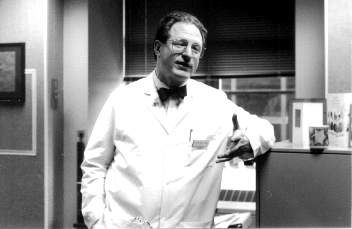 Stephen Straus
Stephen Straus
by Rebecca Kolberg
Almost two years after the FIAU ordeal began, NIH researchers are hoping the final chapter has at last been written with the release of an independent scientific report exonerating the clinical investigators who conducted the ill-fated trial.
The Institute of Medicine (IOM) report, issued in mid-March, is the third -- and final -- review of the circumstances surrounding the toxicity deaths of five patients receiving the experimental anti-hepatitis drug fialuridine (FIAU) in NIH clinical trials. The review was requested by HHS Secretary Donna Shalala, who wanted an outside scientific opinion in addition to reports from the Food and Drug Administration (FDA) and the NIH Director's Advisory Committee.
"It is my belief that the Institute of Medicine report should bring to a close this series of internal and external investigations of our fialuridine studies. The IOM articulated full support for clinical trials in chronic hepatitis B virus infection and of our actions in the three fialuridine studies conducted intramurally," says Stephen Straus, chief of the Laboratory of Clinical Investigation at NIAID, who led the FIAU studies along with Jay Hoofnagle, director of NIDDK's Division of Digestive Diseases and Nutrition.
Although Hoofnagle declines to comment on the specifics of the IOM report, he says, "It was obviously carefully and thoroughly done and provides very sound recommendations."
Like the NIH report issued in April 1994, the IOM panel, chaired by Morton Swartz, a professor of medicine at Harvard Medical School in Boston, concluded that there was no way that clinical researchers could have predicted FIAU's toxicity. "This was an unexpected, sudden tragedy," Swartz says. "The researchers did everything they could to protect the lives of these patients."
In contrast to the findings of the IOM panel, the FDA report contended that the researchers had committed "serious violations" of federal rules governing clinical trials. The IOM committee also disagreed with FDA's call for considering all adverse health events reported in experimental drug trials as related to the drugs themselves. Such a provision, the IOM experts argued, could sharply increase the number of drugs abandoned early in the development process that, with further testing and development, could prove to be both safe and effective.
Acknowledging that probably nothing could have averted the tragic outcome of the FIAU trial, the IOM report goes on to suggest some changes in the regulation of drug trials. The recommendations include:
"The IOM offered balanced and well-reasoned suggestions regarding modifications to clinical research that would further ensure its safety," Straus says. "I, for one, favor adoption of their recommendation for a national mechanism of compensating subjects for injuries that arise during research."
Although the patients and families in the trial, along with Hoofnagle, Straus, and their colleagues, were at the epicenter of the FIAU tragedy, the patient deaths and ensuing investigations also sent ripples of apprehension through clinical research centers everywhere. Consequently, Associate Director for Clinical Research John Gallin says that every NIH investigator should take heart in the IOM panel's conclusions that appropriate procedures were followed in the FIAU intramural trial and that patients received medical care "equal to or above prevailing standards."
In fact, when all is said and done, the painful lessons from the FIAU trial may actually serve to strengthen the clinical research community as a whole. As Straus observes: "The cumulative impact of the IOM report and last year's report of the Director's Advisory Committee investigation of the fialuridine studies can only serve to restore confidence that clinical research is a valued national priority and that investigators need not fear that their actions be held to unattainable standards."